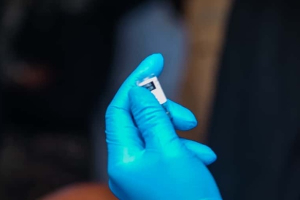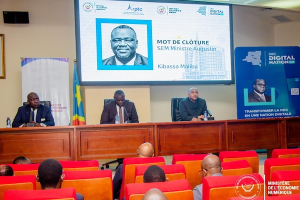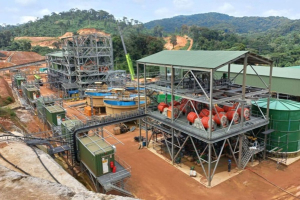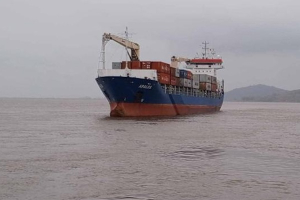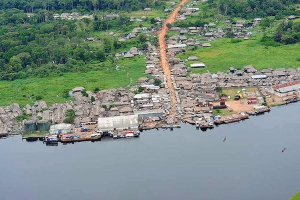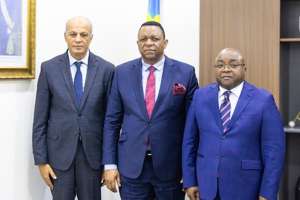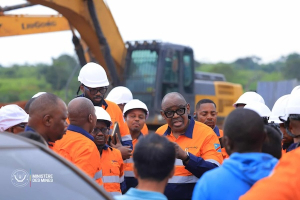Equipe Publication
Lutte contre Ebola : l’Union européenne mobilise 1,8 million € pour la RDC
Le 8 octobre, l’Union européenne a annoncé avoir mobilisé 1,8 million d’euros de financement humanitaire dans le cadre de son dispositif d’intervention d’urgence, afin de renforcer la riposte à la résurgence du virus Ebola dans la province du Kasaï, en République démocratique du Congo (RDC). Ce financement, mis en œuvre par l’intermédiaire de son Centre de coordination de la réaction d’urgence (ERCC), s’inscrit dans le dispositif global de soutien européen déployé sur le terrain.
Selon la délégation de l’Union européenne en RDC, l’appui comprend notamment un hélicoptère spécialement équipé pour faciliter les évacuations et le transport du matériel médical. Des bureaux et des hébergements temporaires ont également été installés à Bulape, la zone de santé touchée, afin d’accueillir jusqu’à 36 experts de la santé. Deux experts norvégiens, spécialisés dans les évacuations sanitaires et l’isolement des patients, rejoindront en outre l’équipe de réponse et de coordination de l’Organisation mondiale de la santé (OMS), via le mécanisme de protection civile de l’UE.
La résurgence de l’épidémie d’Ebola avait été déclarée le 4 septembre par le ministre de la Santé publique, Roger Kamba, après la confirmation de plusieurs cas dans la zone de santé de Bulape. Le virus demeure pour l’instant contenu dans cette aire de santé, un signe encourageant pour les autorités sanitaires qui craignaient une propagation vers les zones voisines. Cette perspective avait justifié l’élaboration par la Croix-Rouge d’un plan de riposte estimé à 25 millions de dollars, visant environ 965 000 personnes sur douze semaines, dont près de 23 200 directement affectées — malades, contacts, soignants et volontaires — ainsi qu’environ 680 000 habitants vivant dans des zones à risque.
Dans sa mise à jour du 5 octobre, l’OMS a fait état d’une tendance à la stabilisation. Aucun nouveau cas confirmé ou probable n’avait été enregistré depuis dix jours, signe d’un contrôle progressif de la transmission. Depuis le début de la résurgence, 64 cas ont été signalés, dont 53 confirmés et 11 probables, avec 43 décès, soit un taux de létalité de 67,2 %. Quinze patients sont considérés comme guéris, tandis que six restaient hospitalisés au centre de traitement d’Ebola. L’OMS a précisé que si aucun nouveau cas n’était enregistré et que les derniers patients guérissaient, la RDC pourrait entamer le compte à rebours de 42 jours avant la déclaration officielle de la fin de l’épidémie.
Timothée Manoke
Lire aussi :
Ebola au Kasaï : la Croix-Rouge lance un appel de 25 millions $ pour renforcer la riposte
DRC Launches $1.5 Billion Digital Plan to Become Regional Tech Hub by 2030
• The Democratic Republic of Congo (DRC) plans to invest $1 billion in public funds and secure an additional $500 million from international partners to implement its new five-year digital strategy.
• The plan aims to transform the DRC into a regional digital hub by 2030, with a focus on AI, connectivity, and digital inclusion.
• The country’s first national artificial intelligence (AI) strategy will include the creation of a Congolese AI academy to train young talent and foster innovation.
The Democratic Republic of Congo (DRC) has launched the drafting process for its National Digital Plan 2026–2030 (PNN2) and its first National Artificial Intelligence Strategy, the Ministry of Digital Economy said on Wednesday.
Minister Augustin Kibassa Maliba announced the initiative, which aims to position the DRC as a regional digital hub by 2030.
“This is about capturing the dividends of digital transformation and positioning our country — rich in critical minerals essential to the digital and energy transitions — as both an investment catalyst and a provider of solutions to global challenges,” Kibassa said.
The new plan will rest on four main pillars: infrastructure and connectivity development, creation of digital public platforms and services, human capital enhancement and digital inclusion, and strengthening of cybersecurity and digital trust.
It will also integrate five cross-cutting axes — digital entrepreneurship, innovation, technological sovereignty, artificial intelligence, and strategic partnerships — to ensure coherence across policy areas.
To support this roadmap, the government plans to invest $1 billion in public funds over five years, complemented by $500 million in external financing already secured from international partners.
As part of the AI strategy, authorities will establish a Congolese Artificial Intelligence Academy to train young professionals, promote applied research, and stimulate local innovation.
This initiative follows the National Digital Plan “Horizon 2025”, launched in 2019, which achieved about 60% of its objectives. The first plan laid the groundwork for the digital economy through improvements in fiber-optic connectivity, regional integration projects such as CAB5, and the introduction of e-government tools like online tax portals and customs modernization via a single window system.
Ongoing projects include the digitization of civil registration and the establishment of a national digital ID system.
With PNN2, Kinshasa seeks to consolidate these achievements and accelerate its digital transformation. A GSMA report presented last month estimated that digital technologies could contribute 9.8 trillion Congolese francs (about $3.6 billion) to the economy by 2029, provided that fiscal and regulatory reforms advance.
The same report suggested that digital adoption could unlock 8.6 trillion FC in additional economic value across mining, agriculture, and public services.
Through this new strategy, the DRC aims to strengthen its technology ecosystem, create thousands of skilled jobs, and attract more investment in high-growth digital sectors.
This article was initially published in French by Samira Njoya, Agence Ecofin
Adapted in English by Ange Jason Quenum
Numérique : la RDC élabore un plan quinquennal de plus de 1,5 milliard $
Le ministre congolais de l’Économie numérique, Augustin Kibassa Maliba, a lancé, le mercredi 8 octobre, les travaux de rédaction du Plan national du numérique 2026-2030 (PNN2) et de la première Stratégie nationale de l’intelligence artificielle (IA). Ces documents visent à propulser la RDC au rang de hub numérique régional à l’horizon 2030.
« Il s'agit de capter les dividendes du numérique et de positionner notre pays, riche en minerais critiques indispensables aux transitions numérique et énergétique, comme un catalyseur d'investissements et un pourvoyeur de solutions face aux grands défis de notre époque », a déclaré Augustin Kibassa.
Le nouveau plan repose sur quatre piliers : le développement des infrastructures et de la connectivité, la mise en place de plateformes et services publics numériques, la valorisation du capital humain et l’inclusion numérique, ainsi que la cybersécurité et la confiance numérique. Il intégrera également cinq axes transversaux, dont l’entrepreneuriat numérique, l’innovation, la souveraineté technologique, l’IA et les partenariats stratégiques.
Pour soutenir cette feuille de route, le gouvernement prévoit un investissement public d’un milliard de dollars sur cinq ans, auquel s’ajouteront 500 millions de dollars d’appuis extérieurs déjà garantis par les partenaires internationaux. Une académie congolaise de l’intelligence artificielle sera également créée dans le cadre de la stratégie d’IA afin de former les jeunes talents, d’encourager la recherche appliquée et de stimuler l’innovation locale.
Cette initiative s’inscrit dans la continuité du plan national du numérique « Horizon 2025 », lancé en 2019, dont le taux de réalisation est estimé à environ 60 %. Ce premier plan a permis de poser des bases solides, comme l’amélioration de la connectivité grâce à la fibre optique nationale et aux projets régionaux (CAB5), l’introduction des premiers services d’e-gouvernement (portail des impôts en ligne), la modernisation du système douanier (guichet unique), la numérisation progressive de l’état civil et la mise en place en cours d’un système d’identification numérique.
Avec le PNN2, Kinshasa entend consolider ces acquis pour accélérer la transformation numérique du pays. Selon un rapport de la GSMA présenté le mois dernier, le numérique pourrait ajouter environ 9 800 milliards de francs congolais (FC) à l’économie nationale d’ici 2029, à condition de réaliser des réformes fiscales et réglementaires. La même source estime que l’adoption des technologies numériques pourrait libérer plus de 8 600 milliards FC de valeur économique dans les secteurs des mines, de l’agriculture et des services publics.
À travers cette nouvelle stratégie, la RDC espère non seulement renforcer son écosystème technologique, mais aussi créer des milliers d’emplois qualifiés et attirer davantage d’investissements dans les secteurs à forte intensité numérique.
Samira Njoya, Agence Ecofin
Lire aussi :
Numérique : Tshisekedi promet un milliard $ d’investissement public d’ici 2030
Réformes des télécoms : un apport de 9 800 milliards F au PIB mis en avant en RDC
Bisie : Alphamin relève sa prévision à au moins 18 000 tonnes d’étain pour 2025
Pour l’exercice 2025, Alphamin Resources vise désormais une production comprise entre 18 000 et 18 500 tonnes à sa mine d’étain de Bisie, en République démocratique du Congo. « La société prévoit de produire environ 5 000 tonnes d’étain contenu au cours du dernier trimestre, ce qui, combiné à sa production cumulée de 13 566 tonnes depuis le début de l’année, porte les prévisions annuelles entre 18 000 et 18 500 tonnes, contre 17 500 tonnes auparavant », indique le rapport opérationnel publié le 8 octobre dernier.
Alphamin, qui tablait initialement sur 20 000 tonnes en 2025, avait abaissé sa cible à 17 500 tonnes en avril dernier, après la suspension d’un mois de ses opérations face à l’avancée de groupes rebelles dans l’Est du pays. Cet arrêt temporaire avait provoqué une baisse de 4 % de la production au deuxième trimestre. La société s’attend toutefois à de meilleures performances, les « installations de traitement continuant d’afficher de bons résultats ».
Au troisième trimestre, Alphamin a produit 5 190 tonnes, soit une hausse de 26 % par rapport au trimestre précédent. Reste à confirmer, au dernier trimestre, la réalisation de l’objectif révisé. Pour mémoire, la mine de Bisie avait livré 17 324 tonnes en 2024.
ASH, Agence Ecofin
Lire aussi :
Mine d’étain de Bisie : Alphamin rate son objectif de production au 2e trimestre
Étain : Alphamin baisse ses objectifs de production de 14 % en RDC
Port de Boma : Maersk met fin à dix années d’inactivité commerciale
Le port de Boma, situé dans le sud-ouest de la République démocratique du Congo, a accueilli le mardi 8 octobre 2025 le navire MV APALOS, exploité par Maersk Congo. Il s’agit du premier navire commercial à accoster dans ce port depuis plus de dix ans, selon l’Agence congolaise de presse (ACP). Le bâtiment transportait une quantité importante de conteneurs.
La maire intérimaire de Boma, Claudelle Phemba, a indiqué que cette escale faisait suite à une réunion tenue le 8 juillet 2025 entre la mairie et Maersk Congo, au cours de laquelle la société avait confirmé son intention de reprendre ses activités dans ce port. Pour Maersk Congo, cette opération s’inscrit dans une stratégie de diversification des points d’accès logistiques à travers le pays, en réponse à la demande croissante d’infrastructures portuaires modernes et efficaces.
En complément de cette escale commerciale, huit nouveaux bateaux de pêche industrielle, construits en Égypte par la société Pyrlant Shipyard, doivent également accoster à Boma avant leur mise en service.
L’accostage du navire de Maersk et l’arrivée attendue des bateaux de pêche industrielle pourraient marquer le début d’une relance des activités au port de Boma, longtemps resté à l’arrêt.
BK
Lire aussi :
Corridor ferroviaire : Kinshasa–Matadi redémarre, l’extension vers Banana en vue
Port de Matadi : l’Onatra relance ses opérations grâce à des travaux de réhabilitation
Cobalt : le système de quotas toujours incomplet à l’approche de son entrée en vigueur
À quelques jours de l’entrée en vigueur du système de quotas à l’exportation du cobalt en République démocratique du Congo (RDC), fixée au 16 octobre 2025, le texte d’application n’a toujours pas été rendu public, relève l’avocat d’affaires Romain Battajon dans un post sur LinkedIn. Président de la commission juridique de la Chambre des mines de la Fédération des entreprises du Congo (FEC), il exprime une préoccupation partagée par l’ensemble des acteurs de la filière.
Ce texte est particulièrement attendu : il doit préciser les conditions d’obtention et d’attribution des quotas, ainsi que les nouvelles règles en matière d’exportation, incluant les frais de régulation et de contrôle, l’instauration d’un système de prépaiement des contributions dues à l’État et le nouveau dispositif de formalités douanières. Sans ce cadre, aucune exportation de cobalt ne pourra être effectuée, ce qui risquerait de prolonger de facto l’embargo au-delà du 15 octobre.
Cette incertitude pèse notamment sur le chinois CMOC. Ses deux filiales congolaises, Tenke Fungurume et Kisanfu, ont exporté ensemble 95 779 tonnes en 2024. L’entreprise, dont le principal actionnaire est CATL, dépendant du cobalt congolais pour répondre à la demande croissante des véhicules électriques et autres applications industrielles en Chine. Sa filiale IXM, spécialisée dans le négoce de métaux, avait d’ailleurs déclaré un cas de force majeure le 30 juin dernier sur ses contrats de fourniture, après la prolongation de l’embargo en RDC.
Le 20 septembre 2025, l’Autorité de régulation et de contrôle des marchés des substances minérales stratégiques (ARECOMS) avait annoncé la fin de l’embargo et l’entrée en vigueur du système de quotas dès le 16 octobre. Pour le dernier trimestre 2025, un plafond de 18 125 tonnes est prévu (3 625 tonnes en octobre, puis 7 250 tonnes en novembre et décembre). Pour 2026 et 2027, le plafond annuel a été fixé à 96 600 tonnes.
Boaz Kabeya
Lire aussi :
Cobalt : la RDC fixe ses quotas d’exportation, le chinois CMOC sous pression
Sous-traitance : Rawbank, l’ARSP et le FOGEC lancent des prêts jusqu’à 1 million $
L’Autorité de régulation de la sous-traitance dans le secteur privé (ARSP), le Fonds de Garantie pour l’Entrepreneuriat au Congo (FOGEC), la Rawbank et Rawsur ont mis en place un programme national de financement destiné aux sous-traitants congolais opérant dans les secteurs minier, énergétique et des infrastructures.
Présenté le 6 octobre 2025 à la Première ministre Judith Suminwa, ce projet vise à faciliter l’accès au crédit pour les petites et moyennes entreprises (PME) congolaises, afin de leur permettre de répondre aux appels d’offres et d’exécuter des marchés. Selon les services de communication de la Primature, les prêts proposés varieront entre 10 000 et 1 million de dollars, en fonction de la taille et de la capacité de chaque entreprise.
L’intervention de Rawbank se fera par le biais de son programme « 20 000 PME ». Doté d’une enveloppe globale de 200 millions de dollars, ce programme vise à intégrer des PME aux chaînes de valeur des grandes entreprises. En juillet dernier, le directeur de la banque, Rawji Mustafa, avait indiqué, lors d’une rencontre avec l’ARSP, que 8 000 PME avaient déjà bénéficié de ce dispositif. L’ARSP facilitera désormais le financement des 12 000 entreprises restantes, en s’appuyant sur son expertise, notamment via sa direction de suivi des marchés, pour identifier les PME crédibles et assurer leur accompagnement.
Le directeur général de l’ARSP, Miguel Kashal, a souligné que cette initiative permettrait non seulement de financer les PME mais aussi d’assurer des paiements rapides par les sociétés principales, renforçant ainsi leur croissance : « Nous transmettrons à Rawbank la liste des sous-traitants ayant remporté des marchés. L’objectif est de soutenir ces entrepreneurs afin qu’ils se développent et deviennent des acteurs majeurs, car il est impossible de réaliser de grandes affaires sans l’accompagnement des banques. »
De son côté, le FOGEC garantira les crédits octroyés, réduisant ainsi le risque pour la banque et renforçant la confiance du secteur financier envers les entreprises locales. Un mécanisme de suivi et d’encadrement sera également mis en place pour assurer la bonne gestion des fonds et la viabilité des projets financés.
Ronsard Luabeya
Lire aussi :
Sous-traitance en RDC : un contrôle annoncé pour assainir un marché de 8,5 milliards $
Hydrocarbures: les sous-traitants désormais soumis à un agrément ministériel en RDC
Sous-traitance en RDC : plus de 2 milliards $ de contrats signés en 2024
Route Gemena–port d’Akula : début de la réhabilitation prévu d’ici fin octobre
Face aux difficultés d’approvisionnement qui paralysent une partie des activités économiques dans le Sud-Ubangi, le ministre des Infrastructures et Travaux publics, John Banza, a annoncé le lancement, avant la fin du mois d’octobre, des travaux de réhabilitation de la route Gemena–Akula. Il a précisé que le gouvernement avait déjà débloqué les fonds nécessaires pour la remise en état de cet axe, ainsi que pour la route de Ndongo.
Le 7 octobre 2025, le ministre a reçu la sénatrice Nadine Boboy, venue plaider pour la réhabilitation de ces deux routes. Elle a alerté sur la dégradation avancée de ces axes stratégiques, qui entrave l’approvisionnement de la ville de Gemena. Selon elle, l’état actuel de la route empêche les camions d’y circuler, obligeant les passagers à passer la nuit à la belle étoile. Le retour des pluies a, en outre, aggravé la situation, rendant la circulation presque impossible.
Longue de 117 km, la route Gemena–Akula relie la ville de Gemena au port fluvial d’Akula, principal point d’évacuation des produits agricoles vers Kinshasa et d’autres centres urbains. Sa remise en état est jugée essentielle pour rétablir la fluidité du trafic et soutenir le commerce local.
Il convient de rappeler qu’en juillet dernier, le Fonds national d’entretien routier (FONER) avait déjà engagé des travaux d’entretien sur ce tronçon, financés à hauteur de 681 829,96 dollars américains et exécutés par l’Office des routes pour une durée prévisionnelle de 90 jours, hors intempéries. À cette période, seulement 50 % des fonds avaient été décaissés, le solde devant suivre dans les semaines suivantes.
Ronsard Luabeya
FPI : un système de gestion numérique attendu d’ici la fin de l’année
A la sortie d’une audience avec le directeur général du Fonds de promotion de l’industrie (FPI), Hervé Claude Ntumba Batukonke, début octobre à Kinshasa, le directeur général de la société tunisienne Système informatique de gestion automatisée (SIGA), Zouheir Ben Ali, a annoncé que la mise en production du système numérique du FPI interviendrait d’ici la fin de l’année 2025, ouvrant la voie à la digitalisation de l’institution publique.
Cette initiative s’inscrit dans l’ambition du FPI de digitaliser l’ensemble de ses services, un objectif placé parmi les priorités du programme de réforme de la nouvelle direction. Lors de la cérémonie de remise et reprise en août dernier, Hervé Claude Ntumba avait souligné que la modernisation technologique serait au cœur de sa stratégie de gestion. Dans le plan triennal 2026-2028 du FPI, la digitalisation complète des processus organisationnels figure également parmi les priorités, afin d’accroître l’efficacité et la transparence des opérations.
Selon le DG de SIGA, deux phases du projet ont déjà été achevées : celles des études et de l’installation du système. « Nous avons démarré la phase de paramétrage du système avec les départements, donc aujourd’hui pratiquement nous sommes dans la phase 3 », a-t-il expliqué à l’issue de sa rencontre avec le DG du FPI.
D’après les informations internes au FPI, la firme SIGA a été sélectionnée à l’issue d’un appel d’offres international lancé en juillet 2024, portant sur la « fourniture, l’installation et la mise en œuvre d’un système de gestion intégrée (ERP) ». Un an plus tard, en juillet 2025, l’établissement annonçait être sur le point de conclure officiellement le partenariat avec SIGA. À ce jour, les détails de ce partenariat n’ont pas encore été rendus publics.
SIGA se présente comme une société spécialisée dans le développement de logiciels et de solutions informatiques, notamment dans la conception de systèmes de gestion intégrés personnalisés et de systèmes d’information adaptés aux besoins d’institutions publiques et privées. Selon les informations disponibles sur son site officiel, elle conçoit également des systèmes interactifs à large portée en temps réel, reposant sur des bases de données optimisées et des technologies de quatrième génération (4G). Le FPI précise que SIGA gère déjà les systèmes informatiques de la Société des chemins de fer de Tunisie, de Tunisie Telecom, de la compagnie aérienne Tunisair, ainsi que de plusieurs banques.
Établissement public à caractère financier, le FPI a pour mission de promouvoir l’industrie locale afin de renforcer l’autonomie de l’appareil de production et d’assurer l’équilibre industriel national. Ses ressources sont destinées à financer des projets industriels, à soutenir la recherche et l’innovation, ainsi qu’à développer les infrastructures économiques.
Entre avril 2024 et mai 2025, le FPI a ainsi alloué près de 6,5 millions de dollars de crédits à six projets dans des secteurs tels que la fabrication de produits pharmaceutiques, de meubles, de boissons, de savons et l’imprimerie, selon les données publiées sur son site officiel.
Timothée Manoke
Compte unique du Trésor : l’intersyndicale redoute la perte d’autonomie financière du FPI
Kibali Gold Mine Hit by Illegal Mining, Losses Unclear
Ten illegal gold mining sites have reportedly been identified inside the concessions of Kibali Gold Mines, a subsidiary of Canada’s Barrick Gold, in Haut-Uélé province.
The finding was announced on October 5, 2025, after an inspection led by Mines Minister Louis Watum Kabamba, joined by the provincial governor and security officials.
The Kibali concessions, covering about 1,836 square kilometers in the Moto goldfields of Watsa territory, are among ten permits held by the company. Officials say these areas are regularly invaded by illegal artisanal and semi-industrial miners.
At Barrick Gold’s 50th annual conference in 2023, CEO Mark Bristow had already warned about the rise of illegal mining in parts of Haut-Uélé, citing the involvement of foreign operators, mainly of Asian origin.
During the minister’s visit, several Chinese nationals were caught mining inside one of the concessions. They were carrying out open-pit artisanal and semi-industrial operations using heavy machinery and employing Congolese workers in unsafe conditions, in violation of the Mining Code.
Provincial authorities and security forces dismantled the network. The minister ordered the arrest of those involved, the seizure of equipment, and the closure of the site. He denounced the illegal exploitation of national resources by foreign operators.
The scale of Kibali Gold’s losses is still unclear. However, during a meeting with the Mines Minister on September 18, 2025, industry representatives called encroachment on mining concessions the “most critical problem.” The Federation of Enterprises of Congo (FEC) estimates that the phenomenon has already cost at least one mining company more than $3 billion through illegal extraction.
Ronsard Luabeya





